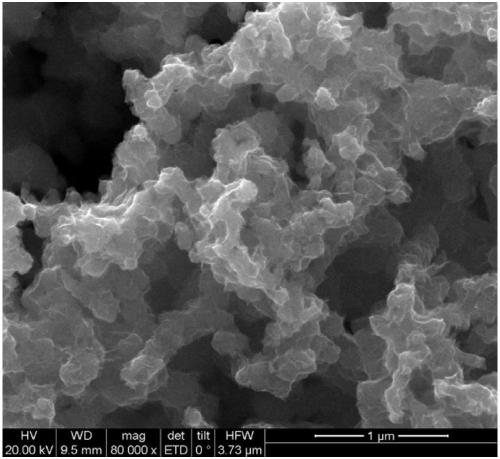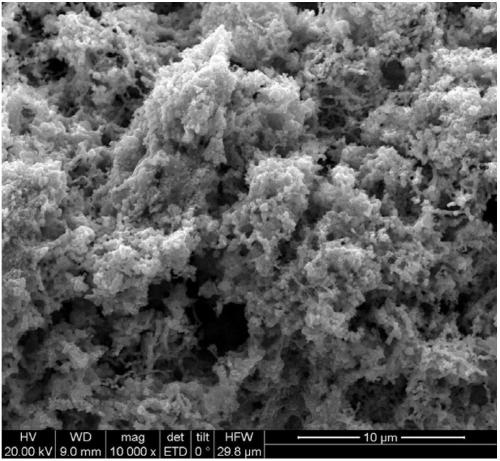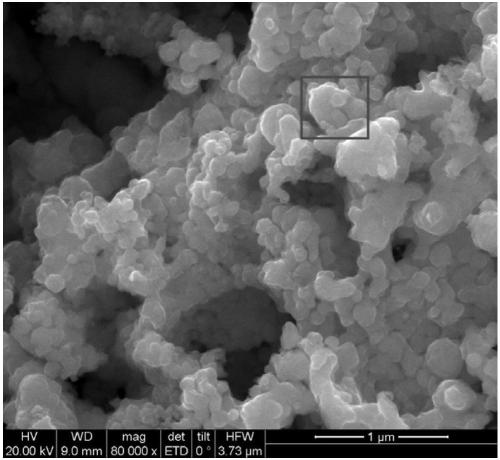Method for treatment of hexavalent chromium water with modified iron-copper bimetallic nanoparticles
A bimetallic nanometer and hexavalent chromium technology, which is applied in the field of hexavalent chromium-polluted water bodies, can solve problems such as low activity, easy oxidation, and uneven dispersion, so as to avoid contact with oxygen, accelerate electron transfer, and improve The effect of transfer efficiency
- Summary
- Abstract
- Description
- Claims
- Application Information
AI Technical Summary
Problems solved by technology
Method used
Image
Examples
Embodiment 1
[0040] A method for treating hexavalent chromium water with modified iron-copper bimetallic nanoparticles, comprising the following steps:
[0041] Take 7 parts of Cr(VI) polluted groundwater with a volume of 100mL and an initial concentration of 100mg / L. (CS-Fe / Cu-1), mixed evenly, and treated at a constant temperature of 25°C for 90min.
[0042] After the reaction was completed, extract 1mL supernatant with a 1mL syringe, filter through a 0.45 μm filter to obtain the filtrate, measure the concentration of residual Cr(VI) in the filtrate by ultraviolet spectrophotometry, and calculate the removal rate of Cr(VI), the result As shown in Table 3 below.
[0043] Control group: Take 7 parts of Cr(VI) polluted groundwater with a volume of 100mL and an initial concentration of 100mg / L. Particles (Fe / Cu), mixed evenly, and treated at a constant temperature of 25°C for 90min.
[0044] After the reaction was completed, extract 1mL supernatant with a 1mL syringe, filter through a 0.4...
Embodiment 2
[0067] A method for treating hexavalent chromium water with modified iron-copper bimetallic nanoparticles, comprising the following steps:
[0068] Weigh respectively the modified iron-copper bimetallic nanoparticles (CS-Fe / Cu-1), starch-modified iron-copper bimetallic nanoparticles (ST-Fe / Cu), carboxymethyl cellulose in 0.05g embodiment 1 Modified iron-copper bimetallic nanoparticles (CMC-Fe / Cu), were added to Cr(VI)-contaminated groundwater with a volume of 100mL, a pH of 7.0, and an initial concentration of 100mg / L, and mixed evenly. Under constant temperature conditions, constant temperature treatment was carried out for 90 minutes.
[0069] After the reaction was completed, extract 1mL supernatant with a 1mL syringe, filter through a 0.45 μm filter to obtain the filtrate, measure the concentration of residual Cr(VI) in the filtrate by ultraviolet spectrophotometry, and calculate the removal rate of Cr(VI), the result As shown in Table 1 below.
[0070] Table 1 Treatment...
Embodiment 3
[0076] A method for treating hexavalent chromium water with modified iron-copper bimetallic nanoparticles, comprising the following steps:
[0077] Add 0.05 g of modified iron-copper bimetallic nanoparticles (CS-Fe / Cu-2) into Cr(VI)-contaminated groundwater with a volume of 100 mL, a pH of 7.0, and an initial concentration of 100 mg / L. Constant temperature treatment under constant temperature conditions.
[0078] When the reaction time is 10min, 15min, 20min, 30min, 40min, 60min, 90min, extract 1mL supernatant with a 1mL syringe, filter through a 0.45μm filter to obtain the filtrate, and measure residual Cr(VI) in the filtrate by UV spectrophotometry concentration, and calculate the removal rate of Cr(VI), the results are shown in Table 2 below.
[0079] Table 2 The treatment effect of modified iron-copper bimetallic nanoparticles of the present invention on Cr(VI) polluted groundwater under different treatment time conditions
[0080] time (min)
10
15
20 ...
PUM
| Property | Measurement | Unit |
|---|---|---|
| Particle size | aaaaa | aaaaa |
Abstract
Description
Claims
Application Information
 Login to View More
Login to View More - R&D
- Intellectual Property
- Life Sciences
- Materials
- Tech Scout
- Unparalleled Data Quality
- Higher Quality Content
- 60% Fewer Hallucinations
Browse by: Latest US Patents, China's latest patents, Technical Efficacy Thesaurus, Application Domain, Technology Topic, Popular Technical Reports.
© 2025 PatSnap. All rights reserved.Legal|Privacy policy|Modern Slavery Act Transparency Statement|Sitemap|About US| Contact US: help@patsnap.com



